Author: Carl Stenberg
Getting the Right Fit: The Governing Board’s Role in Hiring a Manager
Hiring a manager may be the most important decision a local governing board makes. To make sure the new manager will be a good fit for the organization, the board needs to agree on expectations for the new manager and design a process that will enable it to hire the best candidate for the job. This guide, part of the Local Government Board Builders series, provides local elected officials with an overview of their responsibilities in hiring a public manager and outlines the essential steps in a successful hiring process.
“I believe this publication would be an extremely valuable resource for municipalities that are in the process of hiring a manager. Not only can it offer officials immediate detailed instruction and guidance in the process of developing the profile, assessing, and hiring the best candidate, but it is as close as their fingertips for follow up review and future use.”Hartwell Wright
Human Resources Consultant
North Carolina League of Municipalities
“Vaughn M. Upshaw, John A. Rible IV, and Carl W. Stenberg’s Hiring a Manager is an excellent resource … it raises key points that both boards and managers should consider in the hiring process. This publication can increase the likelihood of the fit right for both the board and the new manager.”Michael McLaurin
Town Manager
Town of Waxhaw
…
Continued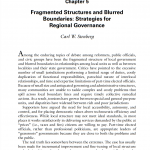
Fragmented Structures and Blurred Boundaries: Strategies for Regional Governance
Among the enduring topics of debate among reformers, public officials, and civic groups have been the fragmented structure of local government and blurred boundaries in relationships among local units as well as between localities and their state government. Critics have pointed to the excessive number of small jurisdictions performing a limited range of duties, costly duplication of functional responsibilities, parochial nature of interlocal relationships, and time and expertise limitations of part-time elected officials. Because of small size and antiquated governing and administrative structures, many communities are unable to tackle complex and costly problems that spill across local boundary lines and require timely collective remedial actions. As a result, tensions have grown between special and general-purpose units, and disparities have widened between rich and poor jurisdictions Supporters have argued the need for local accessibility, autonomy, and control, and for placing democratic values above technocratic efficiency and effectiveness. While local structure may not meet ideal standards, in most places it works satisfactorily in delivering services demanded by the public at “prices” (i.e., taxes and fees) citizens are willing to pay. Part-time elected officials, rather than professional politicians, are appropriate leaders of “grassroots” governments because they are close to both the problems and the public.
Cite as:
Stenberg C.W. (2008) Fragmented Structures and Blurred Boundaries: Strategies for Regional Governance. In: Morgan I.W., Davies P.J. (eds) The Federal Nation. Studies of the Americas. Palgrave Macmillan, New York
…
Continued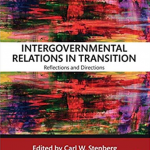
Intergovernmental Relations in Transition: Reflections and Directions
The field of intergovernmental relations has changed substantially over the past five decades. It maintains a critical and evolving role in the US federal system as well as in public policy and administration. Building upon the legacy of Deil S.Wright’s scholarship, this collection of essays by distinguished scholars, emerging thought leaders, and experienced practitioners chronicles and analyzes some of the tensions and pressures that have contributed to the current state of intergovernmental relations and management.
Although rarely commanding media attention by name, intergovernmental relations is being elevated in the public discourse through policy issues dominating the headlines. Many of these intergovernmental issues are addressed in this book, including health insurance exchanges under the now-threatened Affordable Care Act, and the roles of the federal, state, and local governments in food safety, energy, and climate change.Contributors interpret and assess the impacts of these and other issues on the future directions of intergovernmental relations and management. This book will serve as an ideal text for courses on intergovernmental relations and federalism, and will be of interest to government practitioners and civic and nonprofit organization leaders involved in public policy and management.
Cite as:
Stenberg, C. and Hamilton, D. (2018). Intergovernmental Relations in Transition. Milton, UNITED KINGDOM: Routledge.
…
Continued
The Future of Local Government: Will Current Stresses Bring Major, Permanent Changes?
The Great Recession’s damaging effects on the finances of cities and counties have led some observers to predict dramatic, widespread, and enduring changes to local government in response to fiscal pressure. However, the history of change in local government suggests otherwise, as does the experience of individual cities and counties that have confronted fiscal duress in the past. The authors of this article suggest that financial problems will not overwhelm the balance among an array of competing pressures that already confronted local governments long before the recession. Although some cities and counties will respond to the downturn with major, permanent changes, most will not. For local governments as a whole, equilibrium among the host of tensions they face will continue to resist dramatic moves and favor only gradual change.
Cite as:
Ammons, D. N., Smith, K. W., & Stenberg, C. W. (2012). The Future of Local Government: Will Current Stresses Bring Major, Permanent Changes? State and Local Government Review, 44(1_suppl), 64S-75S. https://doi.org/10.1177/0160323X12454143
…
Continued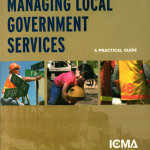
Managing Local Government Services: A Practical Guide
An indispensable resource, this comprehensive text on the subject of local government services is relevant to local governments of all sizes. It includes demographic, economic, technological and cultural trends that affect the management of service delivery. New chapters discuss the shift from “government” to “governance,” alternative methods of service delivery, community development, and the five management practices that are fast becoming the standard for professional local government management.
Cite as:
Austin, S., W. Stenberg, Carl (2007). “Managing Local Government Services: A Practical Guide”
…
Continued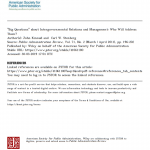
“Big Questions” about Intergovernmental Relations and Management: Who Will Address Them?
Since the death of the U.S. Advisory Commission on Intergovernmental Relations (ACIR) in 1996, important intergovernmental issues have remained on the country’s agenda. Shortly after the 2008 presidential election, for example, the Federal Systems Panel (2008) of the National Academy of Public Administration delivered an “Intergovernmental Agenda” to the incoming administration asserting a need to “restructure intergovernmental management across the federal system” on the basis of “collaboration rather than command and control.” The agenda cited such policy challenges as health care access (e.g., Medicaid) and cost reductions, housing, natural
disasters, terrorism, energy consumption, unemployment, and infrastructure. The agenda disappeared in the bowels of the White House.
Cite as:
Kincaid, J., & Stenberg, C. (2011). “Big Questions” about Intergovernmental Relations and Management: Who Will Address Them? Public Administration Review, 71(2), 196-202. Retrieved from http://www.jstor.org/stable/41061180
…
Continued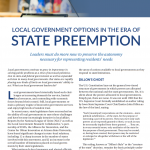
Local Government Options in the Era of State Preemption
Local governments have historically faced such challenges as increasing demands for service, limited
fiscal resources, and contending with economic forces beyond their control. Still, local governments remain a primary engine of innovative government services and enjoy high levels of resident trust. In recent years, state legislatures have encroached on the ability of local governments to meet these challenges and have become increasingly intrusive in local affairs. Reports by the National League of Cities (NLC)1 as well as the Local Government Research Collaborative,2 a partnership of ICMA, the Alliance for Innovation, and the Center for Urban Innovation at Arizona State University, have found significant changes in state-local relations, including: 1) a sharp increase in the number of states
involved with this movement, and 2) an increase in the overall number of limitations placed on local governments by their state legislatures. What options do local managers and elected officials have as they try to tailor local public services to the needs and preferences of residents? This article provides an overview of this changing environment and highlights the array of actions available to local governments as they respond to state limitations.
Cite as:
Swindell, D., Svara, J. and Stenberg C.”Local Government Options in the Era of State Preemption”
…
Continued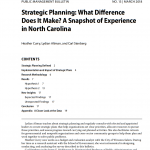
Strategic Planning: What Difference Does It Make? A Snapshot of Experience in North Carolina
This bulletin reports findings of a 2017 School of Government survey of all municipal
and county managers and elected officials in North Carolina to discern their views on the
importance of strategic planning and to determine what difference, if any, it has made in their
roles and relationships. Also included are quotes by local officials who agreed to follow-up
interviews.
Cite as:
Altman, L., Curry H., Stenberg, C.”Strategic Planning: What Difference Does It Make? A Snapshot of Experience in North Carolina.”
…
Continued
